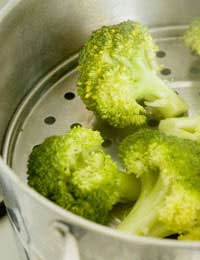Cooking to Preserve Vitamins

Vitamins are substances that are essential to health, and are not manufactured by the body (apart from vitamin D, which is produced in the skin when it is exposed to sunlight).
Vitamins come from food but are destroyed by high cooking temperatures combined with long cooking times. Vitamins can also dissolve into the water that fruit and vegetables are cooked in.
Choosing Vegetables and Fruit
To get the best possible levels of vitamins, pick the freshest-looking vegetables and fruit, and look for the ones with the richest and deepest colours.Preparing Vegetables and Fruit
To retain vitamins, cook fruit and vegetables as soon as possible after preparation – don’t leave them to soak in water, as the water-soluble vitamins will begin to dissolve in the water.Avoid peeling fruit and vegetables if possible – this will help retain nutrients and fibre, and use as much as possible – for example, cook the leaves of broccoli and cauliflower as well as the stalks and florets. Keeping vegetables in larger pieces reduces the loss of vitamins (however, this will increase the cooking time).
Using Little Water
Because water-soluble vitamins leach into the cooking water, one key to preserving vitamins in food is to use as little water as possible. Cooking vegetables in covered dishes in the microwave uses as little as a few teaspoons of water, and takes only a few minutes. Pasta and rice should be cooked in the minimum amount of water, and should not be rinsed before or after cooking.Steaming vegetables avoids them having to touch the water at all. Using a stacked steamer means that two or more different types of food can be steamed over cooking pasta, rice or potatoes, saving energy as well as preserving the nutrients. Pressure-cooking creates superheated steam, so cooks food quickly and in the minimum of water. A full sized pressure cooker can cook a number of different types of food together, so saving energy.
As water-soluble vitamins will have dissolved into any cooking liquid, this can be used to make vitamin-rich (and great tasting) gravy or soup.
If vegetables are being boiled, don’t add bicarbonate of soda to water to keep the colours of the vegetables, as this destroys vitamin C.
Keeping the Temperature Low
Vitamins are destroyed by high cooking temperatures, so using a slow cooker retains vitamins in food by cooking at a lower temperature, as well capturing the vitamin-containing liquids from the meat and vegetables.Cooking Quickly
To retain as many vitamins as possible, don’t overcook fruit and vegetables. Stir frying, because it is so quick, will retain vitamins in vegetables, as will boiling vegetables for a shorter period.Storing Right
Vitamins are also destroyed by storage, so eat fruit and vegetables as soon as possible after purchase (and even as soon as possible after picking – home-grown vegetables cooked within hours of picking taste fantastic and are full of vitamins). As frozen vegetables are frozen within a few hours of picking, they have about the same levels of nutrients as fresh vegetables. Frozen vegetables should be eaten within 6 to 12 months of freezing, as vitamin levels do still fall, although not as quickly as fresh.Business Energy With a Difference
If you are looking for business energy or need advanced solutions like remote energy monitoring, new supplies, downgrading or upgrading capacity, have a no obligation chat with Purely Energy.
To find our more get in touch here. or call 0161 521 3400.







